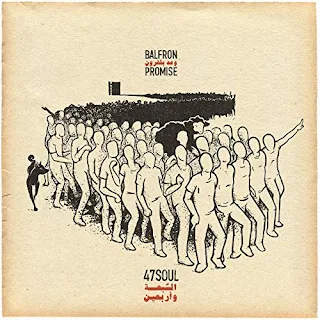The tradition of Y Fari Lwyd which translates to Grey Mary or Grey Mare in English is one of the strangest and most ancient of a number of customs in which people in Wales have used to mark the passing of the
darkest days of midwinter. It certainly has pre-Christian
origins and is said to bring luck.Though the tradition's exact origins are murky, the image of a white horse has been a powerful symbol in the United Kingdom for at least 3,000 years. In Celtic Britain, the horse was seen as a symbol of power and
fertility and prowess on the battlefield. In Celtic mythology, animals
who had the ability to cross between this world and the underworld (the
Celtic Annwn) are traditionally white or grey coloured. Arawn, the King
of Annwn’s dogs, is white with red ears and he rides on a large grey
horse.
The first written record of Mari Lwyd dates back to 1800, in J. Evans’ book ‘A Tour through Part of North Wales’.Traditionally a New Year’s Eve luck bringing ritual Y Fari Lwyd consists of making a horse figure from a horse's skull,( though a genuine horse’s skull is gold dust these days ) with two black cloth ears sometimes sewn onto the cloth, making it look extra horrible, and the eye sockets are often filled with green bottle-ends, or other colored material decorative false ears and eyes attached.They adorn it with colorful reins, bells and ribbons and the equine image of death has an especially ghostly appearance thanks to the white sheet draped over the person carrying it.The lower jaw is sometimes spring-loaded, so that Mari's operator can snap it at passers by or householders.
The Fari Lwyd
and her group go from house to house and pub to pub and try to gain
access by performing a series of verses, or ‘pwnco’ in Welsh. The inhabitants
would reply with their own verses in a battle to outwit Mari and her
gang and prevent her from entering.
Wel, dyma ni'n dwad
Gyfelillion diniwad
I' mofyn am gennad - i ganu
(Translation: Behold here we come, simple friends, to ask for permission to sing.)
Rhowch glywed, wyr doethion
Pa faint ycho ddynion,
A pheth yn wych union -
yw'ch enwau?
(Translation: Let us hear, wise men, how many of you there are, and what exactly are your names?)
Eventually she will be let in, as
this confers luck on the household for the coming year and scares out
anything unwanted from the previous year. Once inside, more songs are
sung and the group is given drinks and food.
The Mari party consists of commedia del’arte characters. The
Merryman plays the fiddle; The Leader, plus top hat, holds the Mari’s
reins; The Sergeant keeps the peace. Pwnsh a Siwan (Punch and Judy) are
played by two male characters.
When the house was entered, Y Fari paid special attention to the
female occupants. This was done by neighing at the women as well as
biting and nudging them. The Merryman played his fiddle while Punch and
Judy began their show.
Judy entered with her broom to clean the
hearth. She was then knocked to the floor by Punch who ran around
attempting to kiss the women of the household. Punch was then chased
through the house by Judy and hit with her broom.
Having sung and
danced, the party would sit to eat food and drink ale. On their
departure, the Mari Lwyd wished the household a Happy New Year.
Dymunwn ich lawenydd
I gynnal blwyddyn newydd
Tra paro'r gwr i dincian cloch
Well, well y boch chwi beunydd
(Translation: We wish you joy to live a new year; as long as the man tinkles his bell, may you improve daily.)
The practice of disguising the characters
was to preserve anonymity and to distance them from everyday life. This
tradition of blackening or colouring the face to take on another
‘character’ can be found in most indigenous cultures and in Britain in
the older Morris sides.
The tradition has similarities to other hooded animal customs in
Britain, such as the ‘Hoodening’ in Kent, the ‘Broad’ in the Cotswolds
and ‘The Old Tup’ in Derbyshire, which involved a group of poor people
trying to find food and money in the harsh depths of the winter.
Although the custom was given various names, it was best known as the
Mari Lwyd; however, the etymology of this term remains the subject of
academic debate.
The folklorist Iorwerth C. Peate believed that the term meant “Holy
Mary” and thus was a reference to Mary, mother of Jesus, while fellow
folklorist E. C. Cawte thought it more likely that the term had
originally meant “Grey Mare”, thus referring to the heads’ equine
appearance.
In other instances, the Mari Lwyd custom is given different names,
with it being recorded as y Wasail “The Wassail” in parts of
Carmarthenshire.
In the first half of the 19th century it was recorded in
Pembrokeshire under the name of y March “The Horse” and y Gynfas-farch
“The Canvas Horse”
The industrial revolution and the rise of fire-and-brimstone chapel
preaching had a serious effect on the Mari Lwyd. The parties had gained a
bad reputation for drunkenness and vandalism as they roamed the
villages. Many a sermon was preached against the continuance of such a
pagan and barbaric practice, and the participants were urged to do
something useful instead, such as taking part in eisteddfodau. Enter Nefydd, the Rev. William Roberts
(1813-1872), a Denbighshire man who became a Blaenau Gwent Baptist
minister. He hated the Mari Lwyd. He wrote a book entitled The Religion
Of The Dark Ages, gave a detailed account of the Mari and transcribed 20
verses, so his congregation could recognise it. He campaigned with
great fervour: “We must try and get the young people of our time more to
interest themselves more in intellectual and substantial things such as
reading and composing poetry, essays, singing etc, as is encouraged and
practised in our Eisteddfodau… I wish of this folly, and of all similar
follies, that they find no place anywhere apart from the museum of the
historian and the antiquary.”
Christmas carols began to be sung at the doors instead and the battle of insults and verse dissapeared, and in some areas the Welsh language gave way to English. By the 1960's the custom of the Mari had almost died out. Only a few Mari processions were left by this time including in Pencoed near Bridgend and Pentyrch near Cardiff.
But the Welsh
population hungrily seized on the fragments of the Mari’s tradition, and
– thanks to Nefydd – we can now study the Mari verses in all their true
splendour, and thankfully there has been a growing interest in Y Fari Lwyd in recent years, which has seen a resurgence in groups performing this tradition across Wales, Maris can now be spotted from Holywell in Flintshire to Pembrokeshire involving bardic battles, revelry and much drinking. I do like a good revival, especially of something as unique and unusual as this.The strength of the Mari tradition can be measured at the National Eisteddfod, which takes place in August. At one Eisteddfod, 30 Maris turned up. Wonderful stuff long may this tradition continue to grow.
The tradition of the Mari Llwyd - BBC Cymru
































